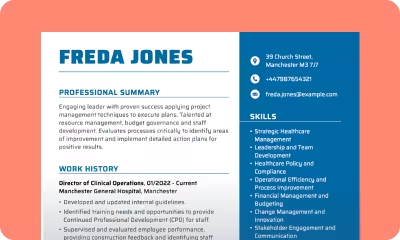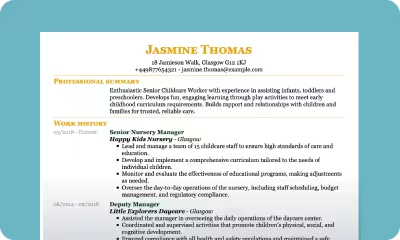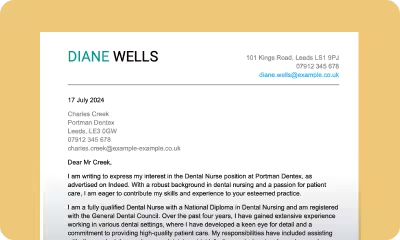What is a CV?
A curriculum vitae, commonly called a CV, is a comprehensive document that details your academic and professional background, including education, work experience, skills and achievements. It represents your professional profile and is an essential part of your application.
Follow these basic guidelines to make a CV that will grab the recruiter’s attention and increase your chances of securing an interview.
CV full form
Here is an example of a professionally designed and well-structured CV. Notice how each element is strategically placed – starting with the most important information (your personal details), followed by your work experience and skills, and ending with sections on education and languages.
To learn more about a particular section, refer to its number and description. Whenever you’re ready to take the next step towards your dream job, explore our CV templates for inspiration and create a winning application.

CV sections
The main components of a CV in the UK typically include:
Contact details
This includes your name and contact information, such as phone number, email, and residency address.
Personal statement
This is a brief paragraph that summarises your professional profile. It may include information about your skills, experience, and career objectives. It is typically 2-4 sentences long and located at the top of the CV.
Work experience
This section lists your previous employment, including the company’s name, job title, employment dates, and your responsibilities and achievements.
Skills
Here, you list any relevant skills, such as computer skills or other specialised abilities relevant to the job.
Education
In this part, you list your academic qualifications, including the names of the institutions you attended, the degrees you earned, and the graduation dates.
Additional information
Here, you can highlight any notable achievements or awards you have received throughout your career, such as publications, patents, or other recognitions, as well as mention your language skills, hobbies, or interests.
How to write a CV step-by-step
Writing a good CV that is tailored to your industry and profession can help you stand out with professionalism and attention to detail. Learn how to write a strong CV that will make you a strong candidate in the job market.
Use our free CV templates to ensure your CV is of the highest standard and save time.
See how easy it is to create a CV with our step-by-step guide:
- Choose your CV template
- Decide on the appropriate CV format
- Add your contact information
- Open your CV with a strong personal statement
- Showcase your experience and work achievements
- Highlight relevant skills
- Add your qualifications
- Add keywords to pass applicant tracking systems
- Proofread and edit to ensure good readability
Choose your CV template
A CV template ensures that you don’t forget any important elements of your CV. It contains all the necessary sections, so all you have to do is fill them in. Choose a template that suits your industry and personal style. You will find a variety of templates in our collection, from simple and conservative to more creative and colourful.
Decide on the appropriate CV format
Choose a CV format that best suits your job profile. Think about your skills, experience and the type of job you’re applying for. There are two main CV formats:
- Chronological: Lists work experience and education in reverse chronological order. It is most often supplemented with key responsibilities and achievements from a particular job, which is why it is sometimes referred to as a combined format.
- Skills-based: Also known as functional. Focuses on skills rather than work history. This format is most often chosen by people who are new to the labour market or who have had long gaps in employment.
The most commonly used format in the UK is chronological, or rather reverse chronological, with the addition of responsibilities and achievements.
Build a professional CV that gets you hired

Add your contact information
Adding your contact details to your CV may seem obvious, but it’s a vital step that shouldn’t be overlooked. Your contact details are essential for potential employers to reach you easily. Ensuring this section is formatted correctly will make your details clear and accessible.
Here’s what you should include:
- Your full name
- Location
If you don’t feel comfortable including your full postal address, consider adding only the city and postcode. Like this:
53 Church Way
Bradford, BD1 9JROr just this:
Bradford, BD1 9JR
- Phone number
Provide a phone number where you can be easily reached. If you have a voicemail, make sure the greeting on it is professional.
- Email address
Use a professional email address, ideally one that includes your name. If you don’t have one, consider creating it for the job.
- Website or portfolio
Including links to your LinkedIn, GitHub or personal portfolio can strengthen your application. A LinkedIn profile shows your professional network and references, a GitHub profile highlights coding projects for technical roles, and a personal website or portfolio is essential for creative fields such as design, writing and art.
Adding these links to your contacts section gives employers direct access to your skills and work.
Here’s how it should look:
Paul Piper
4 Queensway
Sheffield S1 9TH
+44 987654321
paul.piper@example.com
linkedin.com/in/paulpiper
github.com/paulpiper
Open your CV with a strong personal statement
Your personal statement, placed at the top of your CV just after your contact details, serves as an introduction to your professional profile. It is designed to grab recruiters’ attention and encourage further reading. Highlight any notable achievements, experiences or skills that make you stand out from other candidates.
A well-written personal statement should be concise, engaging and communicate why you are the right candidate.
Showcase your experience and work achievements
Structure your work experience section in reverse chronological order, using bullet points to outline your career path and key qualifications. Ideally, focus on your last three roles or the past ten years of your career – emphasise career progression and adaptability. If you have limited experience, highlight internships or volunteer work.
To strengthen your work experience section’s impact, quantify your achievements with tangible values. Providing measurable results gives recruiters clear evidence of your contributions. Instead of saying:
Increased customer satisfaction and retention rate.
Show the impact with numbers:
Increased customer satisfaction by 25% and retention rate by 6% compared to last year’s figures.
Work history
Senior Manufacturing Manager
March 2022 – Current | TechMach Engineering Ltd – Leeds
- Spearheaded all manufacturing operations, including production planning, scheduling, and execution, resulting in a 20% increase in throughput and a 15% reduction in lead times.
- Led the implementation of Lean manufacturing principles and Six Sigma methodologies. Established and maintained strong supplier relationships.
- Established and maintained strong supplier relationships.
- Developed and mentored a high-performing team, fostering a culture of accountability and continuous improvement.
Manufacturing Operations Manager
January 2020 – February 2022 | TechMach Engineering Ltd. – Leeds
- Directed all aspects of manufacturing operations, leading to a 25% improvement in overall equipment effectiveness (OEE).
- Implemented a comprehensive quality management system based on ISO 9001 standards, resulting in a 30% reduction in defects and customer complaints.
- Collaborated closely with engineering and R&D teams to introduce new products to market.
- Managed annual operating budgets, achieving cost savings of 10% through strategic procurement initiatives and process optimisations.
OR
Work history
August 2022 – Current | Stelars – Leeds | HR Administrator
- Accurately processed over 200 leave of absence requests and monitored absence data to use as triggers for management intervention.
- Updated 15 HR policies and documentation in line with legislative developments and GDPR requirements to ensure compliance.
- Reviewed and renewed 10 company policies, ensuring strict legal compliance across all business activities.
- Provided expert HR advice to line managers, resolving 12 conflict resolution cases, 8 pay disputes, and 5 under-performance management issues.
January 2016 – July 2022 | Sunny Co – Leeds | HR Assistant
- Communicated courteously, confidently, and clearly at all levels across the organisation, handling over 50 interactions weekly.
- Ensured the strict confidentiality of sensitive information, securely handling the personal information of 300+ employees.
- Ran payroll processes for over 150 employees monthly and updated employee benefits details.
- Maintained and updated employee files and records, managing over 500 records accurately.
Highlight relevant skills
Employers want candidates who are not only qualified for the job but also adaptable to new challenges. Think about this when listing skills on your CV.
Include about 6-10 qualities that highlight both hard and soft skills. Hard skills are specific to the job you’re applying for, such as technical skills or industry-specific knowledge.
Soft, transferable skills, on the other hand, can be applied in a variety of situations and are crucial for building relationships with colleagues and contributing to a positive working environment. Demonstrate a balanced mix of these skills to show your versatility and willingness to tackle different challenges in the workplace.
Example of transferable skills for a CV:
- Communication
- Teamwork
- Problem-solving
- Time management
- Adaptability
- Organisational skills
- Leadership skills
Add your qualifications
The education section usually appears last on your CV. If you have more than one entry, list them in chronological order, starting with the most recent. For each entry, include the degree or qualification earned, the course of study, the name of the institution, and the year of graduation. This format ensures that employers can easily see your most recent and relevant educational achievements.
Education
University of London, 2019 | Bachelor of Arts, Hospitality Management
London College of Tourism, 2017 | Diploma, Travel and Tourism
Add keywords to pass applicant tracking systems
Many employers use applicant tracking systems (ATS) to screen CVs. To ensure your CV gets through the initial screening process, read the job posting carefully to identify keywords that describe the most important requirements and responsibilities. Look for the specific skills, qualifications and experience the employer is looking for to know which words to include in your CV. Use these keywords naturally throughout your CV, especially in sections such as your professional profile, work experience, skills and education.
Action verbs for your CV
Some words are more persuasive than others. Using strong action verbs can help you better express your achievements and responsibilities. Here are some powerful action verbs to consider:
- Facilitated
- Engineered
- Improved
- Enhanced
- Coordinated
- Revamped
- Collaborated
- Supervised
- Launched
- Produced
- Initiated
- Maximised
- Streamlined
- Developed
- Generated
- Transformed
- Formulated
- Executed
- Achieved
- Created
- Directed
- Negotiated
- Managed
- Designed
- Led
- Orchestrated
- Integrated
- Implemented
- Optimised
- Researched
Proofread and edit to ensure good readability
Carefully proofread your CV to ensure it is error-free and demonstrates your professionalism and attention to detail. Check it thoroughly for spelling and grammatical errors and inconsistencies in formatting.
Edit your CV so it fits neatly on one page, is concise and focuses on relevant information. A well-organised and tailored CV increases your chances of making a positive impression on potential employers. This approach demonstrates commitment and professionalism, which increases the chances of a successful application.
How to write a good CV for different roles
Writing a CV isn’t a one-size-fits-all process – your approach should vary depending on your situation. Below, you’ll find tailored tips to help you create a strong CV, whether you’re a recent graduate with no work experience, changing careers, applying for an academic role or facing other unique circumstances.
Just click on the scenario that applies to you to see our expert tips on highlighting your strengths, structuring your CV effectively, and making the best possible impression on recruiters.
How to write a good CV for UK job applications
When writing a CV for the UK market, start with a clear headline with your contact details. Unlike in some other countries, there’s no need to include a photo of yourself or personal details such as your age or marital status.
Proceed to write a brief summary of your work experience and career goals, followed by your education. Next, outline your work experience by detailing previous roles, dates of employment, key responsibilities, and notable achievements. Highlight your skills, including work-related skills such as knowledge of software programs or foreign languages.
It’s also important to keep your CV neat and clear, using simple and legible fonts and clear headings and paragraphs. Try to tailor your CV to the job advert you are applying for so that you highlight your skills and experience to the job requirements.
How to write a good CV with no work experience
When creating a CV with no work experience, you should focus on your strengths, skills, and potential.
Start with a strong personal statement that highlights your key qualities, interests, and career goals.
Focus on your education:
List your degrees or qualifications
Include relevant coursework or academic projects that show off your skills and knowledge
Add volunteer work or internships, even if they aren’t directly related to the role. They can still show useful experience like teamwork, organisation, or communication.
Include extracurricular activities or hobbies that demonstrate valuable skills:
Leadership (e.g. captain of a sports team)
Teamwork (e.g. group projects or clubs)
Initiative (e.g. running a blog or tutoring)
Highlight transferable skills, such as:
Communication
Problem-solving
Time management
Digital literacy
Keep your CV clear and well-organised:
Use bullet points
Stick to a simple layout with easy-to-read fonts
Tailor your CV to the job advert. Show how your skills and experiences match the employer’s needs, even if you haven’t held a formal job before.
Be honest about your level of experience, but focus on your enthusiasm, willingness to learn, and the strengths you bring to the role.
How to write a good CV as a student
Writing a CV as a student is much like writing one without formal work experience. A great way to begin is by choosing a professional CV template to guide your layout.
Start with your name and contact details clearly at the top.
Write a short personal statement that outlines:
Your key strengths and interests
Career goals
Relevant coursework or extracurricular activities
Focus on your education:
List your degree, qualifications, and predicted or achieved grades
Mention relevant coursework, projects, or research that shows off your knowledge and skills
Highlight leadership roles or involvement in clubs and societies
Include transferable skills, such as:
Communication
Teamwork
Time management
Problem-solving
If you have any work experience, part-time jobs, or internships — even if unrelated — list them. They show responsibility and a willingness to learn.
Use bullet points to keep your CV easy to scan and make sure your formatting is clean and consistent.
Always tailor your CV to the specific role or industry. Highlight the most relevant skills and experiences for each application.
Before submitting, take the time to proofread carefully to avoid spelling or grammar mistakes. A polished, well-structured CV makes a strong first impression.
How to make a CV at 16
If you’re 16 and writing your first CV, keep it simple, clear, and focused on your strengths.
Start with your personal details:
Full name
Address
Phone number
Professional-sounding email address
Write a short personal statement that highlights:
Your strengths and interests
Career goals
Relevant hobbies or achievements
Next, list your education:
Name of your school
Dates attended
Subjects you’re studying
Predicted or achieved grades
Include any work experience, such as:
Part-time jobs
Volunteering
Internships or work placements
For each, mention the organisation, your role, and your main responsibilities.
Add a skills section, including:
Computer or IT skills
Communication or teamwork abilities
Languages
Awards or school achievements
Make sure to tailor your CV to each job. Highlight the experience and skills most relevant to the role you’re applying for.
Finally, check your CV carefully for spelling and grammar mistakes. Ask a teacher, parent, or friend to proofread it. A polished CV helps you make a strong first impression.
How to write a CV for a customer service job
To write a CV for a customer service job, start with a brief personal statement. Then, follow it up with your work experience and relevant skills. List the places you’ve worked and the positions you’ve held, including the dates you worked there. Be sure to include any specific skills or techniques you’ve mastered (e.g., handling customer complaints, inbound and outbound phone calls, specific problem-solving).
Then, mention your education and qualifications. This includes any relevant courses or certifications you’ve completed and any formal education you’ve received. Ensure that your CV is well-formatted, easy to read, and error-free.
How to make a CV for a job in retail
To write a CV for a job in retail, start with a strong personal statement that highlights your skills, experience, and career aspirations. Emphasise your relevant experience, education, and skills.
Retail job skills might include:
- customer service,
- product knowledge,
- sales techniques.
Make sure to tailor your CV to the job by using keywords from the job description. Keep your CV concise and use bullet points to make it easy to read.
How to write a CV for a teacher
When writing a CV for a teacher in the UK, you should focus on highlighting your relevant qualifications, experience, and skills. Start with a brief personal statement outlining your teaching philosophy and key experience. Emphasise your communication skills and any additional skills or relevant experience. You may also use this section to explain why you want to work at the school or institution.
Next, provide information about your experience. Under each position, list three to four responsibilities or achievements you’re proud of in that job. In the skills section, highlight the skills relevant to the position you’re applying for. End your CV with information about your education.
How to make a CV for a project manager
If you’re applying for a project manager position, make sure that – in addition to a well-written personal statement – your project manager CV includes a detailed list of your professional experience, including your job titles, the companies you have worked for, and the dates of employment. Use bullet points to describe your responsibilities, achievements, and the outcomes of your projects.
Complete your CV with a list of your key skills that are relevant to project management, such as project planning, risk management, budget management, and stakeholder management.
Finally, add information about your education, including your degree, diploma, or any relevant certificates, and any additional training or courses you have completed.
How to write a good academic CV
An academic CV is a detailed document that outlines a person’s academic and professional qualifications, research experience, publications and teaching experience. It is typically used by individuals who apply for academic positions, such as research, teaching or administrative positions at universities or other academic institutions.
An academic CV is usually longer than a standard CV and provides a comprehensive overview of relevant academic and professional achievements. The content and structure of an academic CV may vary depending on the field of study and the level of position you are applying for.
How to write it?
- As with any CV, start with your personal details, including your name and contact information.
- Add a personal statement that highlights your research interests, academic achievements, and career goals.
- Then, list your academic qualifications, including degrees obtained, institution name, and attendance dates. Don’t forget to mention any research or academic positions you’ve held, including teaching assistant, research assistant, or lecturer positions.
- Highlight your academic achievements, including any publications, conference presentations, and grants or awards received.
- List any relevant skills, such as research methodology, data analysis, or language skills.
- Mention any professional memberships or affiliations, such as being a member of scientific societies or serving as a reviewer for scientific journals.
- Academic CVs usually include references. You should add these at the end, but before you do, make sure that the people you list consent to this.
- Finally, ensure your CV is well formatted with clear headings and bullet points and has no spelling or grammatical errors.
How to make a CV for first job applications
Creating your first CV is all about highlighting your strengths, education, and potential — even if you don’t have job experience yet.
Include your contact details
Add your name, phone number, email, and location.
Write a short personal statement
Briefly explain who you are, your strengths, and what kind of role you’re aiming for.
Focus on education
List your school, dates, grades (predicted or achieved), and any relevant subjects.
Add any experience
Mention part-time jobs, volunteering, school projects, or placements. Use bullet points to describe what you did.
List key skills
Include things like:
Teamwork
Communication
Time management
IT skills
Keep it clear and tailored
Use a clean layout, check for errors, and adjust your CV for each job you apply to.
Even with no experience, a well-presented CV can help you make a great first impression.
It only takes
MINUTES for an average MyPerfectCV user to create a CV
How to make a CV in 3 simple steps
- Fill in a quick and easy form
- Tailor the CV to your liking
- Download and apply
Additional CV sections to include
As you already know, writing a good CV involves tailoring it to the job requirements and your own experience. While a standard CV includes core sections such as work experience and education, you can enhance it by including additional sections that make you stand out.
In addition to the core sections, you can enhance your CV with the following optional sections:
Voluntary work
It’s particularly useful if you’re writing a CV without much work experience. The volunteering section can demonstrate your commitment and skills gained through unpaid work.
Professional memberships
Often added to academic CVs, this section lists memberships in professional organisations relevant to your field.
Languages
When listing languages, indicate your proficiency level (e.g. beginner, intermediate, fluent, or A, B, C, depending on the scale you prefer to use).
Hobbies and interests
Give a brief overview of your personal interests and hobbies. This section can help to show your individuality and personality outside of work.
References
Instead of listing references, it’s common in the UK to state “References available on request”. If you choose to include them, give the names and contact details of people who can provide references for you, such as former colleagues or supervisors.
Additional CV writing tips
The aim of writing a CV is essentially to present your qualifications and achievements in the best possible light to secure a job interview invitation.
Here are 6 tips to improve your CV writing:
- Choose an aesthetically pleasing, professional CV template
Choose a clean, professional CV template with subtle colours. This will help you make a positive first impression and stand out from the competition.
- Provide strong, relevant content
Thoroughly review the job description and include relevant keywords in your CV. This will ensure that your CV passes through applicant tracking systems (ATS) and is seen by recruiters. Proofread your CV carefully to eliminate any errors or typos that can detract from your professionalism.
- Use strong action verbs
Use strong action verbs such as “managed,” “improved,” or “achieved” to emphasise your impact and achievements. These words convey your proactive contributions and results.
- Highlight achievements with quantifiable data
Showcase your contributions by providing specific numbers and measurable values. For example, “increased sales by 20%” or “managed a team of 10 people”. Quantifying your achievements makes them more tangible and impressive.
- Use a professional CV format
Make sure your CV is clearly structured and easy to navigate. Choose a simple font and layout with clearly defined headings. Use a reverse chronological format to present your most recent experience first.
- Be concise
Aim to keep your CV to one page and focus on relevant information. Use concise language when describing your roles, achievements and skills, and ensure that each section enhances your candidacy for the job.
What is the purpose of a CV
The purpose of a CV or curriculum vitae is to provide potential employers or academic institutions with a comprehensive summary of your professional profile, outlining your education, work experience, skills, achievements and other relevant information.
A CV is mainly used for:
Applying for a job
This is the most common use of a CV. Employers review your CV to determine if you are a suitable candidate for the position. By summarising your work history, education and skills, they can decide whether to invite you for an interview.
Applying for an academic position
An academic CV is usually much longer, ranging from a few pages to a dozen. It contains detailed information about your educational background, research experience, publications, presentations and other academic achievements.
Applying for a grant or funding
If you are applying for a grant or funding, you may be asked to submit your CV along with other documents. Your CV should highlight the relevant qualifications, experience and achievements that make you a strong candidate for the funding.
Networking and professional development
A well-designed CV can be a valuable tool in building your professional network. It provides a snapshot of your career and achievements, which can help you make a strong impression on potential business contacts and open up new opportunities.
What should a CV look like
Once you’ve perfected the content of your CV, it’s time to focus on its design.
The ideal layout depends on your industry and company culture. While creative fields find modern designs with bold colours acceptable, corporate environments typically prefer a clean and classic approach.
Below you’ll find different types of CV designs to consider, including:
What should a British CV look like
A British CV typically includes a concise personal statement, detailed work experience, educational history, relevant skills and optional sections for achievements and references. It should be well organised and tailored to the job you are applying for, with a clear focus on professionalism and clarity.
What should a modern CV look like
A modern CV often has a clean, visually appealing design with sections such as a personal profile, skills summary, work experience in reverse chronological order, education and additional sections for achievements or interests. It may include links to portfolios or online profiles.
What should a chronological CV look like
A chronological CV lists work experience and education in reverse chronological order, starting with the most recent job or qualification. It emphasises career progression and continuity, making it suitable for candidates with a stable work history in a traditional format.
What should a PDF CV look like
A PDF CV should maintain consistent formatting across devices and platforms. It should include all standard CV sections such as personal information, work experience, education, skills and optional sections. Fonts should be legible and the layout should be visually appealing without compromising on clarity.
What should a CV with no experience look like
A CV of a candidate with no professional experience should highlight transferable skills gained through education, volunteering or personal projects. It may focus more on education and skills sections, with achievements and personal attributes that demonstrate readiness and enthusiasm for the role.
What should a free CV in word format look like
A CV in word format should be well-structured and easy to edit. It typically includes sections such as personal details, career objective or personal statement, work experience, education, skills and optional sections for achievements or interests. It should be formatted to ensure readability and compatibility with different versions of Word.
Common mistakes to avoid when writing a CV
Even if you have years of experience and this isn’t your first time writing a CV, mistakes can still happen. Luckily, we’re here to help you ensure your application stands out for all the right reasons. Here are some common CV writing mistakes and how to avoid them:
Grammatical and spelling errors
Your CV represents your professional abilities, so it is important to ensure that it is well-written and free of errors. Always proofread your CV multiple times and then ask someone to check it for you.
Not tailoring your CV
Each job application is unique, and your CV should be tailored to each job you apply for. Make sure to highlight the skills and experience that are most relevant to the position.
Using generic language
Avoid using generic language and buzzwords that do not provide any real information about your abilities or experience. Instead, use specific examples and tangible achievements to showcase your skills.
Being too long or too short
Your CV should be long enough to provide a comprehensive overview of your skills and experience but not so long that it becomes tedious to read. As a general rule, aim for a maximum of two pages, but adjust according to the job’s requirements.
Being too creative
While it’s important to stand out from other applicants, being too creative with your CV can backfire. Avoid using unusual fonts or graphics that may distract from the content of your CV.
Key takeaways
Use a professional CV format
The key characteristics of a standard CV are clarity, structure, and minimalism.
Tailor your CV
Tailor your CV design to reflect not only your personality but also the industry you’re applying to.
Quantify your achievements
Creative industries often favour bold, modern CV designs, while corporate sectors prefer a clean, professional layout.
Include keywords from the job description
Ensure readability by using simple, legible fonts and clear section headings.
Be concise
A well-designed CV can significantly increase your chances of standing out in a competitive job market.
The easiest way to create your perfect CV
- 30+ professionally designed CV templates with multiple colour and style options
- Thousands of expert-written bullet points for any job – just click and add to your CV.
- Unlimited sharing and downloading in multiple formats (PDF, DOC and more).
















